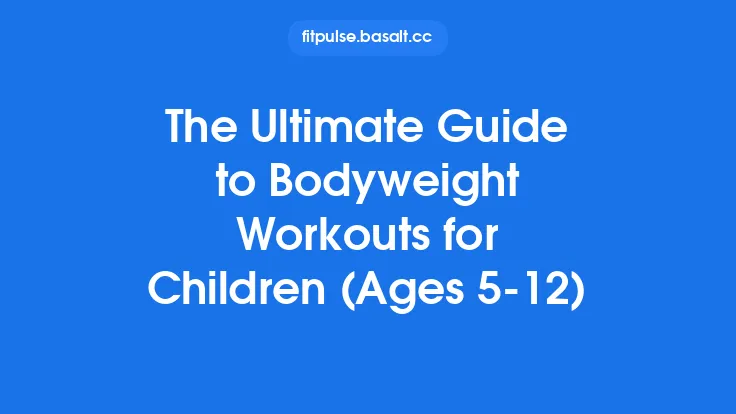Outdoor bodyweight training offers the freedom to move under open skies, but the environment is never static. Temperature swings, precipitation, daylight changes, and even the quality of the air can dramatically affect how safely and effectively you train. Understanding the seasonal nuances of your local climate—and preparing for them—helps you stay consistent, avoid unnecessary setbacks, and make the most of every park, playground, or open‑air gym you visit.
Understanding Seasonal Climate Variables
| Variable | How It Affects Performance | Typical Seasonal Patterns |
|---|---|---|
| Ambient Temperature | Influences muscle elasticity, cardiovascular strain, and sweat rate. | Hot in summer, cold in winter, moderate in spring/fall. |
| Relative Humidity | Alters evaporative cooling; high humidity reduces sweat effectiveness, raising core temperature. | Peaks in summer monsoons, low in winter. |
| Barometric Pressure | Can affect joint fluid dynamics and perceived exertion. | Slightly lower in high‑altitude summer months, higher in cold seasons. |
| Wind Speed & Direction | Increases convective heat loss (cold) or adds resistance (heat). Can destabilize balance on open platforms. | Variable; gusty in spring, calmer in summer evenings. |
| Precipitation (Rain/Snow) | Changes surface friction, introduces slip hazards, and can soak clothing, reducing insulation. | Rainy in spring, snow in winter, occasional summer showers. |
| UV Index | Determines risk of sunburn and skin damage; also influences vitamin D synthesis. | Highest in midsummer, moderate in spring/fall. |
| Air Quality (PM2.5, pollen) | Impacts respiratory function; high pollutants or allergens can limit endurance. | Poorer in winter (inversions) and spring (pollen). |
By tracking these variables—through a weather app, a personal log, or a simple observation routine—you can anticipate the adjustments needed for each workout session.
Heat and Humidity: Summer Strategies
- Pre‑Workout Acclimatization
- Gradually increase exposure to heat over 7‑10 days (5‑10 % longer sessions each day). This stimulates plasma volume expansion and improves sweat response.
- Use a heart‑rate monitor; aim for ≤ 85 % of max HR during warm‑up in hot conditions.
- Clothing Choices
- Opt for lightweight, moisture‑wicking fabrics (e.g., polyester blends) with UV‑protective finishes (UPF 30+).
- Loose‑fitting garments promote airflow and evaporative cooling.
- Hydration Protocol
- Begin each session with at least 500 ml of water 2 hours prior.
- During the workout, consume 150‑250 ml every 15‑20 minutes; consider electrolyte‑enhanced drinks if sweat loss exceeds 1 % body weight.
- Timing and Shade
- Schedule high‑intensity intervals early morning (5–8 am) or late evening (after sunset) when ambient temperature and UV index dip.
- If training midday, select shaded areas (under trees, canopies, or near tall structures) to reduce radiant heat load.
- Heat‑Related Illness Prevention
- Recognize early signs: excessive thirst, dizziness, rapid pulse, or dark urine.
- Have a cooling plan: a portable misting fan, a damp towel, or a cold water immersion bucket for rapid core temperature reduction.
Cold and Frost: Winter Precautions
- Layering System
- Base Layer: Moisture‑wicking (synthetic or merino wool) to keep skin dry.
- Insulating Layer: Fleece or lightweight down for retained body heat.
- Outer Shell: Wind‑proof, breathable (e.g., Gore‑Tex) to block convective cooling while allowing sweat escape.
- Joint Warmth
- Cold reduces synovial fluid viscosity, increasing joint stiffness. Use compression sleeves for knees, elbows, and wrists to retain heat and improve proprioception.
- Footwear & Traction
- Choose shoes with aggressive tread patterns and, if needed, add removable ice‑grip spikes.
- Inspect park equipment for ice accumulation; avoid slick metal bars that can cause sudden loss of grip.
- Breathing Management
- In sub‑zero air, inhaled gases can irritate airways. Breathe through a scarf or a breathable mask to warm and humidify the air before it reaches the lungs.
- Warm‑Up Emphasis
- Extend dynamic warm‑up to 10‑12 minutes, focusing on large‑range movements (leg swings, arm circles) to raise core temperature before static holds or plyometrics.
Rain, Mud, and Slippery Surfaces: Spring and Monsoon Tips
- Surface Assessment
- Test the friction of bars, rails, and ground with a quick hand grip before committing to a set.
- Avoid metal structures that have become slick from rain; opt for wooden or coated surfaces that retain grip.
- Footwear Adaptations
- Use shoes with water‑resistant uppers and a rubber outsole designed for wet traction (e.g., Vibram® “Wet Grip”).
- Consider a quick‑dry sock system to prevent blisters caused by prolonged moisture.
- Grip Aids
- Chalk can become ineffective when wet; instead, use a thin layer of liquid grip (e.g., gym‑grade grip spray) that dries quickly on contact.
- Carry a small towel to wipe excess water from bars between sets.
- Movement Modifications
- Reduce explosive plyometric elements (e.g., box jumps) on unstable ground to lower the risk of ankle sprains.
- Emphasize controlled, slower tempo repetitions that allow better balance on slick surfaces.
- Post‑Workout Care
- Immediately change out of wet clothing to prevent hypothermia.
- Dry equipment (if portable) and store it in a ventilated area to avoid rust.
Wind and Air Quality: Managing Outdoor Conditions
- Wind‑Related Adjustments
- Stability: When wind gusts exceed 15 km/h, avoid exercises that rely heavily on balance (e.g., handstand holds) on open platforms.
- Resistance: Use wind as a natural resistance tool for low‑impact cardio (e.g., jogging against a headwind) but monitor for excessive strain on the shoulders and lower back.
- Air Quality Monitoring
- Check local AQI (Air Quality Index) before heading out. If AQI > 100 (moderate), limit high‑intensity intervals; if > 150 (unhealthy), consider indoor alternatives.
- On days with high pollen counts, wear a lightweight mask and schedule workouts after peak pollen hours (typically mid‑morning).
- Breathing Techniques
- Practice diaphragmatic breathing to maximize oxygen uptake, especially when air density is lower (high altitude or windy days).
- Incorporate short “breath‑hold” drills during rest periods to improve CO₂ tolerance, but avoid prolonged holds in polluted environments.
Sun Exposure and UV Protection
- Sunscreen Application: Apply a broad‑spectrum SPF 30+ sunscreen 15 minutes before training; reapply every 2 hours, especially after sweating.
- Protective Gear: Wear a wide‑brim hat or a UV‑blocking cap, and consider sunglasses with polarized lenses to reduce glare on metal bars.
- Skin Monitoring: Conduct a quick skin check after each session; early detection of erythema helps prevent sunburn progression.
Seasonal Clothing and Gear Recommendations
| Season | Core Items | Optional Enhancements |
|---|---|---|
| Spring | Light jacket, breathable shirt, water‑resistant shoes | Packable rain poncho, anti‑slip gloves |
| Summer | UV‑protective shirt, shorts, ventilated shoes | Cooling neck wrap, electrolyte tablets |
| Fall | Mid‑weight fleece, long‑sleeve base, grippy shoes | Hand warmers for early mornings |
| Winter | Thermal base, insulated mid‑layer, windproof shell, insulated shoes | Ice‑grip spikes, heated insoles |
Investing in season‑specific gear reduces the need for improvisation and keeps your focus on movement quality rather than comfort management.
Hydration and Nutrition Adjustments by Season
- Summer: Prioritize fluids with electrolytes (sodium, potassium, magnesium) to offset higher sweat sodium loss. Include a small carbohydrate source (e.g., a banana) pre‑workout to sustain energy in heat.
- Winter: Even though thirst perception drops, aim for 0.5 L of water per hour of activity. Warm beverages (herbal tea) post‑session can aid re‑warming without causing gastrointestinal distress.
- Spring/Fall: Balanced meals with moderate carbs and protein work well; consider a light snack (e.g., trail mix) to maintain glycogen stores during longer daylight sessions.
Allergies, Insects, and Wildlife Considerations
- Pollen Management
- Schedule workouts after 10 am when pollen counts typically dip.
- Use antihistamine eye drops or oral antihistamines if you’re prone to seasonal allergies.
- Insect Protection
- Apply DEET‑based or picaridin repellents on exposed skin.
- Wear long sleeves and pants in high‑mosquito zones; consider clothing treated with permethrin for added protection.
- Wildlife Awareness
- In areas with snakes or larger mammals, perform a quick visual sweep of the training zone before starting.
- Keep a small first‑aid kit with wound‑cleaning supplies for unexpected bites or scrapes.
Daylight Hours and Scheduling Workouts
- Summer: Long daylight allows flexibility; however, the hottest part of the day (12 pm–4 pm) should be avoided for high‑intensity work.
- Winter: Short daylight limits training windows; consider using portable LED lighting for early‑morning or late‑evening sessions, ensuring the area is well‑illuminated to prevent missteps.
- Equinox Periods: Transition weeks can bring rapid temperature swings; keep a versatile clothing kit on hand and be prepared to shift workout times by an hour or two.
Equipment Care and Maintenance Across Seasons
- Metal Bars & Rails:
- Winter: Wipe down after each session to remove moisture and prevent rust. Apply a thin layer of silicone spray for corrosion protection.
- Summer: Clean off sweat and dust; occasional polishing maintains grip.
- Wooden Structures:
- Rainy Seasons: Inspect for splintering or rot; sand rough spots and apply a weather‑proof sealant annually.
- Dry Seasons: Re‑oil or wax to prevent cracking.
- Portable Gear (Parallettes, Rings):
- Store in a dry, temperature‑stable environment. Use silica gel packets in the storage bag to absorb humidity.
Regular maintenance not only extends equipment lifespan but also preserves safety—slippery or compromised surfaces are a leading cause of outdoor injuries.
Seasonal Safety Checklist
| Season | Pre‑Workout | During Workout | Post‑Workout |
|---|---|---|---|
| Spring | Check for rain, bring a lightweight rain jacket, inspect ground for mud. | Keep a towel handy for wet bars, stay aware of insects. | Dry shoes, change out of damp clothes. |
| Summer | Apply sunscreen, hydrate 30 min prior, choose shaded area. | Monitor heart rate, sip water every 15 min, use grip spray if sweaty. | Re‑apply sunscreen, refuel with electrolytes. |
| Fall | Layer clothing for variable temps, test wind conditions. | Adjust intensity if wind gusts > 15 km/h, keep a light jacket nearby. | Warm up with a hot drink, stretch to counter cooler muscles. |
| Winter | Dress in layers, perform extended dynamic warm‑up, check for ice on equipment. | Use ice‑grip spikes, limit high‑impact moves on frozen surfaces. | Change into dry clothes immediately, perform a thorough stretch. |
Closing Thoughts
Seasonal changes are an inevitable part of outdoor training, but they need not be obstacles. By treating temperature, humidity, precipitation, wind, UV exposure, and even local flora and fauna as variables you can measure and manage, you transform each workout into a well‑engineered session—safe, effective, and enjoyable year‑round. Embrace the rhythm of the seasons, equip yourself wisely, and let the outdoors continue to be your most dynamic gym.





